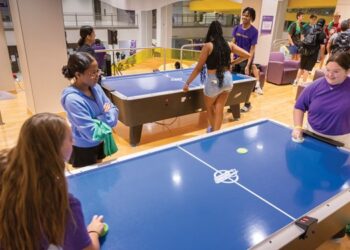Outstanding aquatics facilities are a common feature of many college and university campus recreation centers. Students, faculty and community members have the option to swim laps, play a wide variety of aquatic sports or simply relax poolside.
However, with a multitude of aquatic activities comes a heightened risk for safety hazards. Accidents can happen and it is crucial to ensure all of your aquatic staff are prepared and qualified to handle any situation. In order to help, we have developed a step-by-step process for hiring and training aquatics staff.
1. Provide a comprehensive program overview.
Working as a lifeguard, coach or instructor is no easy task. Ensure future employees are aware of the responsibilities they are about to take on. At the University of Akron Student Recreation and Wellness Center, in Akron, Ohio, the hiring process begins with an information session for all applicants regarding the facility.
“As part of that presentation we give an overview of our facility and what we are all about and that could be for any job — an aquatics job, a front desk job, intramural sports job, etc.,” said Nick Weber, the assistant director for aquatics at the university. “Anyone who is looking for a job with us has to come and learn about our vision and what they would be getting themselves involved with.”
2. Check credentials.
Collect resumes, cover letters and verify all applicants possess the required certifications. According to Cynthia Bartko, the assistant director of aquatics at the University of Alabama Birmingham, to work as a lifeguard at the Campus Recreation Center, applicants must hold a nationally recognized Lifeguard Certification that contains all the in and out of water training, as listed in the new Model Aquatic Health Code (MAHC).
Similarly, at the University of Akron, potential employees must be certified at the time of application. “We prefer American Red Cross, but we are willing to cross people over if we have to, in order to meet the standards that we have set for the rest of our staff,” explained Weber.
3. Conduct a water skills test.
It is one thing to pass a written exam and earn a certification, but it is another to put those skills into action. Guarantee any potential lifeguard, instructor or other aquatic staff are able to take the necessary action, if a situation were to arise.
“They must demonstrate the physical ability and skills to swim 500 yards without stopping, tread water for 2.5 minutes without using their hands, display spinal in-line stabilization techniques, perform in-water rescues, CPR and AED skills,” said Bartko.
As Rachel Cook, the aquatics and certifications coordinator at University of Northern Iowa (UNI) explained, someone might pass the interview with flying colors, but testing their skills is a must.
“I make sure each candidate is physically fit and able to do the skills,” said Cook. “For example, in a lifeguard class it is a requirement to be able to go to the bottom of a 10-foot pool, but our pool is 13 feet so I have to make sure I have people who can get down to the bottom of a 13-foot pool. That is not something I can find out in an interview, but later on in the skills testing.”
4. Provide training.
Once hired, aquatic staff at the University of Akron must complete an extensive training program. Initially, the new employee must perform a walk through with one of the head lifeguards at the facility.
“On every shift we have a pool deck student manager that we call a head lifeguard,” added Weber. “So the head lifeguard walks them around the facility, shows them where all the equipment is, what the processes are, what their responsibilities would be like on a day-to-day basis and go over the emergency action plan.”
Next, new staff attends in-service training, where they run through various scenarios that might occur on the pool deck. Finally, they will complete a shadow shift with a senior staff member.
“Again they are going to go through the role of what a regular lifeguard would do, but they are going to get their hand held by one of our senior-level staff,” explained Weber. “They walk around with them on the pool deck, learn about problem areas we may have, where to scan and much more.”










